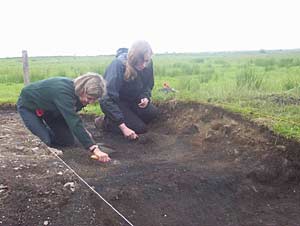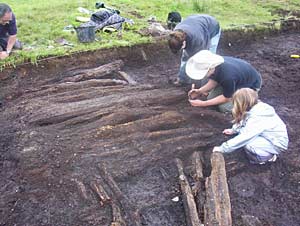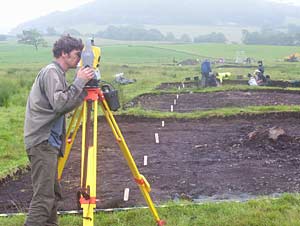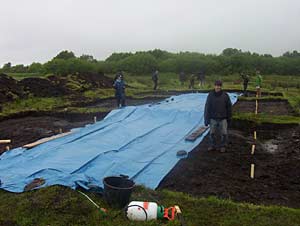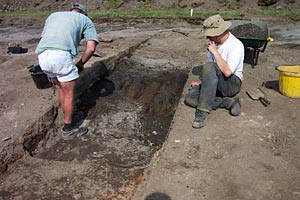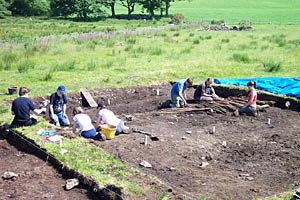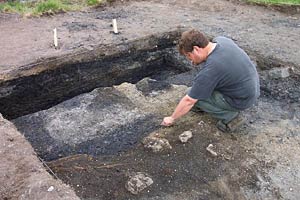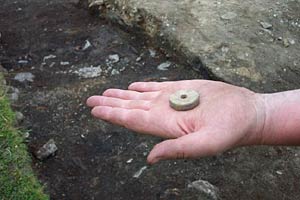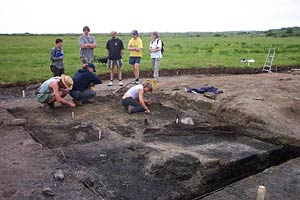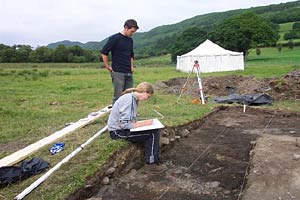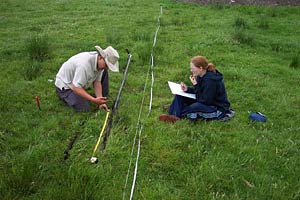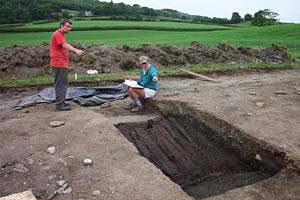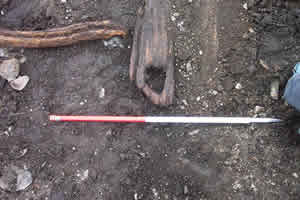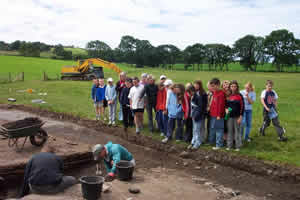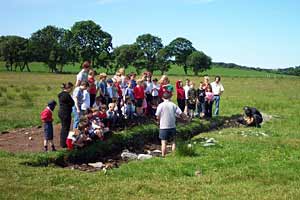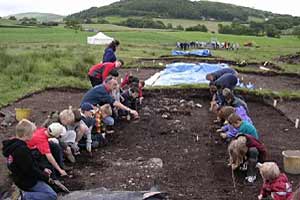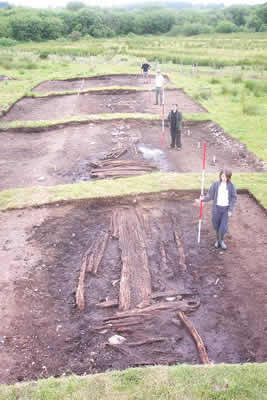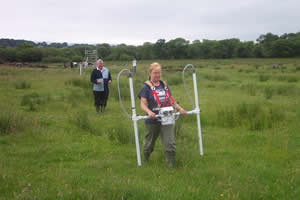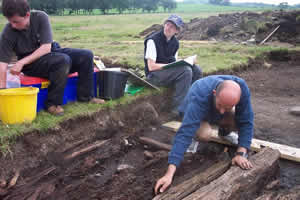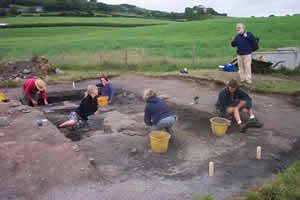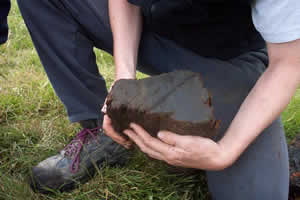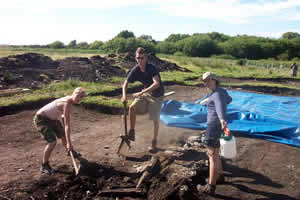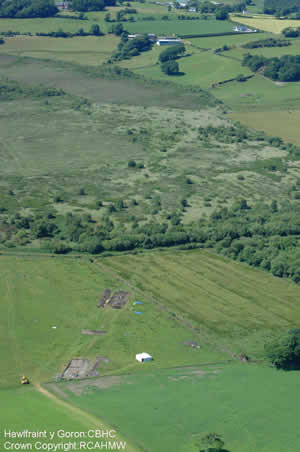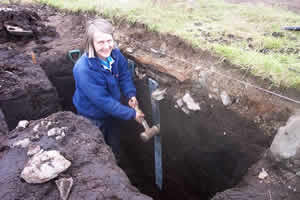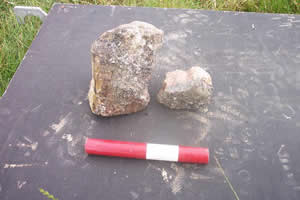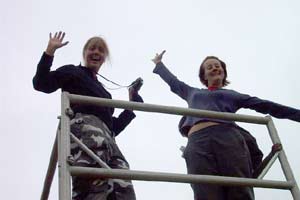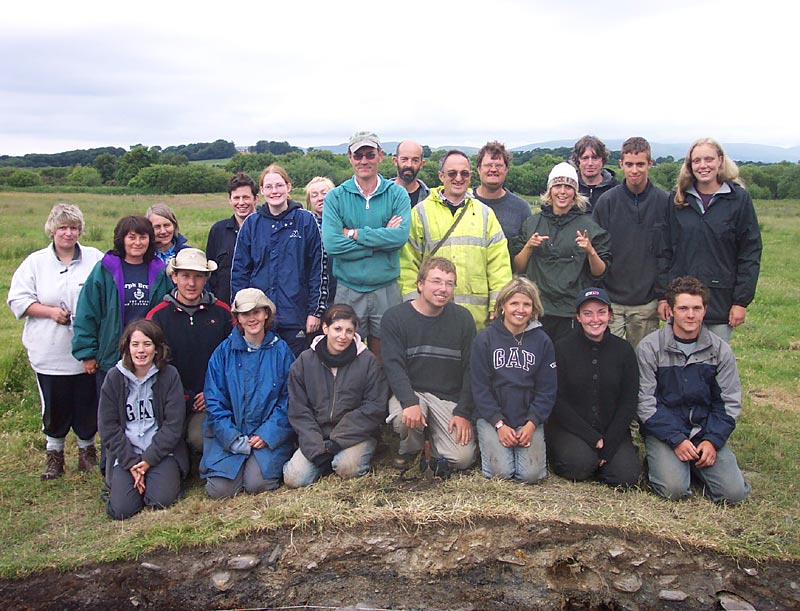Home > |
Dig Diary
|
||||||
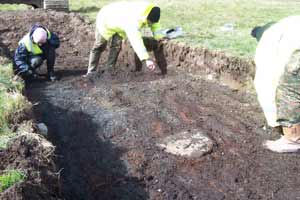 |
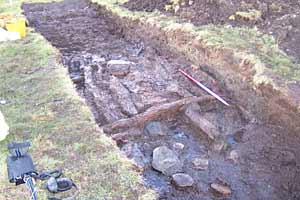 |
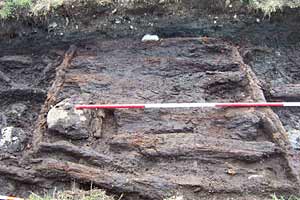 |
The trackway during the trial excavation in March |
||
DIGGING A MEDIEVAL TRACKWAY IN CEREDIGION
During June 2004 Cambria Archaeology is excavating a timber trackway at Llancynfelyn near Talybont in northern Ceredigion. The trackway was first examined in March 2004 when radiocarbon dates were obtained from two wood samples. These dates indicated that the trackway was built some time between AD 900 and AD 1020.
The trackway is on edge of Cors Fochno (Borth Bog). This is an area of wetland containing both tidal and freshwater marshes and it is a site of great ecological importance. For many years the edges of the marshland have been reclaimed for farming. This process is still continuing and has led to the recent discovery of previously unknown archaeological sites. The waterlogged conditions have allowed the survival of materials, such as wood, that would normally decay over time. One such site is the wooden trackway.
The trackway is visible on the surface as a low bank running across a pasture field. A single trench was excavated across the bank in March of this year. The bank was found to cover a series of timbers forming a walkway about 1.5m wide. The timbers had been laid across two wooden ‘rails’ and the whole structure was supported by a series of wooden pegs or stakes hammered into the peat.
Timber trackways of the kind identified at Llancynfelyn have been recorded and excavated in many areas of Britain and Ireland and have a wide date range from the early Neolithic (over 5000 years ago) through to the Medieval period. The pre-Norman conquest dates for the timber trackway at Llancynfelyn were a considerable surprise and adds to the unusual nature of the discovery. It is possible that the trackway provides a routeway across the marsh toward the church and settlement at Llancynfelyn. The excavation of the trackway will help us to understand woodworking techniques and the way that local woodland was managed for timber during the early medieval period. The excavation will also tell us about the nature of the environment 1000 years ago in this area of Ceredigion.
We would like to thank the farmer, Mr Dilwyn Jenkins, for allowing us to excavate in his field, to Cadw for providing financial support and to the students and staff of the University of Birmingham who are helping with the dig.
This webpage provides regular updates on the progress of the excavation
including a ‘dig diary’ and a ‘picture of the
day’. We hope that you will share, with the staff and students
involved in the dig, in the excitement of discovery ‘as it
happens’.
Students from the University of Birmingham cleaning the gravel causeway in Trench 4. |
Day 1 - June 1st Most of the day was spent setting up the excavation and the campsite. Ten students from the University of Birmingham arrived in the afternoon and work began removing the topsoil from the excavation by machine. The first area to be opened up was Trench 4 (Trenches 1,2 and 3 were excavated during the trial excavation in March). It was located at the southern end of the trackway and it measured 25m by 10m. The top of the gravel overlying the timber structure was clearly exposed and work began on cleaning this for photography.
|
||||||
Eifion Jenkins removing the topsoil from above the gravel and timber trackway in Trench 5. The work is being carefully watched by the Site Director Nigel Page of Cambria Archaeology. |
Day 2 - June 2nd The machine moved to the second area to be excavated – Trench 5. This was located near to the northeastern boundary of the field and also measured 25m by 10m. Because this area was in the more waterlogged area of the field it was hoped that the timbers of the trackway would be better preserved. We were not disappointed - the machine soon exposed substantial timber planking. Two fragments of green-glazed pottery, of possible medieval date, were recovered from the overlying gravel. This suggests that the gravel may have been deposited several centuries after the timber trackway had been built. Many thanks to Eifion Jenkins for his expert machining.
|
||||||
Raincoats on! Excavating the burnt wood in Trench 4. |
Day 3 – June 3rd Cleaning continued in both trenches and more of the timber trackway was uncovered. A fragment of possible burnt wood was found in a small pit cut into the trackway in Trench 4. In the afternoon the weather changed with the first rain of the dig. At least it will stop the timbers from drying out!
|
||||||
|
|||||||
|
|||||||
Day 6 – June 8th A very exciting day. The investigation of the pit at the south
end of the trackway in Trench 4 continued. It is much larger than
we originally thought and is full of ash (Picture 1). More importantly
it appears to continue under the wooden trackway and therefore it
must be earlier in date. It could be part of some industrial process
and may even be Roman in date. A stone spindle whorl was found at
the base of the gravel trackway overlying this large pit (Picture
2). Meanwhile a reporter and film crew from the BBC Welsh language
Newyddion programme arrived to film the excavation for S4C (Picture
3). |
|||||||
|
|||||||
|
|||||||
|
|||||||
|
|||||||
|
|||||||
|
|||||||
|
|||||||
|
|||||||
The Excavation Team: Llangynfelyn 2004
|
|||||||




